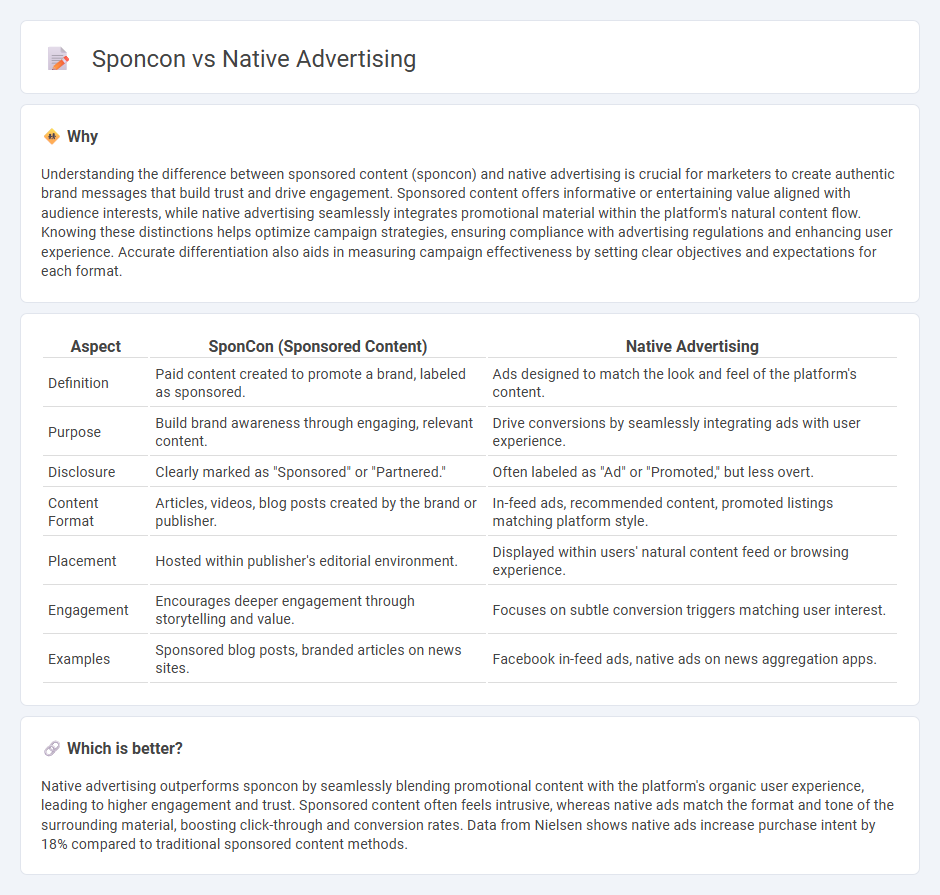
Sponsored content and native advertising both integrate promotional messages within editorial environments to enhance brand visibility and engagement. Sponsored content is created by or in collaboration with the advertiser but aligns closely with the publisher's style, while native advertising mimics the platform's format for seamless user experience. Explore the distinct strategies and benefits of sponcon versus native advertising to optimize your marketing approach.
Why it is important
Understanding the difference between sponsored content (sponcon) and native advertising is crucial for marketers to create authentic brand messages that build trust and drive engagement. Sponsored content offers informative or entertaining value aligned with audience interests, while native advertising seamlessly integrates promotional material within the platform's natural content flow. Knowing these distinctions helps optimize campaign strategies, ensuring compliance with advertising regulations and enhancing user experience. Accurate differentiation also aids in measuring campaign effectiveness by setting clear objectives and expectations for each format.
Comparison Table
| Aspect | SponCon (Sponsored Content) | Native Advertising |
|---|---|---|
| Definition | Paid content created to promote a brand, labeled as sponsored. | Ads designed to match the look and feel of the platform's content. |
| Purpose | Build brand awareness through engaging, relevant content. | Drive conversions by seamlessly integrating ads with user experience. |
| Disclosure | Clearly marked as "Sponsored" or "Partnered." | Often labeled as "Ad" or "Promoted," but less overt. |
| Content Format | Articles, videos, blog posts created by the brand or publisher. | In-feed ads, recommended content, promoted listings matching platform style. |
| Placement | Hosted within publisher's editorial environment. | Displayed within users' natural content feed or browsing experience. |
| Engagement | Encourages deeper engagement through storytelling and value. | Focuses on subtle conversion triggers matching user interest. |
| Examples | Sponsored blog posts, branded articles on news sites. | Facebook in-feed ads, native ads on news aggregation apps. |
Which is better?
Native advertising outperforms sponcon by seamlessly blending promotional content with the platform's organic user experience, leading to higher engagement and trust. Sponsored content often feels intrusive, whereas native ads match the format and tone of the surrounding material, boosting click-through and conversion rates. Data from Nielsen shows native ads increase purchase intent by 18% compared to traditional sponsored content methods.
Connection
Sponcon (sponsored content) and native advertising both integrate promotional material seamlessly within editorial content to enhance user engagement by mimicking the format and style of the platform. These strategies prioritize subtle brand promotion, increasing authenticity and consumer trust compared to traditional ads. Their connection lies in delivering non-disruptive advertising that aligns with user experience, optimizing marketing effectiveness and conversion rates.
Key Terms
Disclosure
Native advertising and sponsored content both require clear disclosure to maintain transparency and comply with advertising regulations such as the FTC Act in the US and ASA guidelines in the UK. Proper labeling like "Sponsored," "Ad," or "Paid Partnership" helps audiences identify promotional material while preserving content credibility. Explore best practices for disclosure to enhance trust and comply with legal standards.
Content Integration
Native advertising seamlessly blends branded content within a platform's editorial environment, maintaining the format and style to enhance user engagement and trust. Sponsored content (sponcon) explicitly acknowledges brand sponsorship, often taking the form of articles, videos, or posts that promote a product or service but remain distinct from regular editorial content. Explore more about how content integration strategies impact audience perception and campaign effectiveness.
Authenticity
Native advertising seamlessly integrates branded content within user experience to enhance authenticity and engagement while providing clear disclosure to maintain transparency. Sponsored content (sponcon) often aligns brand messages with relevant media platforms, leveraging influencer credibility to foster trust and resonate with target audiences. Explore deeper insights on optimizing authenticity strategies in digital marketing campaigns.
Source and External Links
What is Native Advertising - How it Works - Outbrain - Native advertising is paid content that matches the look, feel, and function of the media where it appears, designed to engage consumers by blending seamlessly with editorial content and driving better return on ad spend than traditional display ads.
The Good, the Bad, and the Ugly of Native Advertising - Clearcode - Native advertising is a form of online media advertising that mimics the visual design and user experience of a website, making it more effective in capturing user attention and increasing purchase intent compared to traditional banner ads.
What is native advertising? - Adjust - Native advertising refers to paid media designed to visually and functionally integrate with a platform's natural content, offering benefits such as higher engagement, improved click-through rates, better ROI, ad blocker resistance, and greater brand awareness.
 dowidth.com
dowidth.com